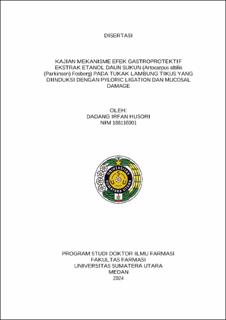Kajian Mekanisme Efek Gastroprotektif Ekstrak Etanol Daun Sukun (Artocarpus altilis (Parkinson) Fosberg) pada Tukak Lambung Tikus yang Diinduksi dengan Pyloric Ligation dan Mucosal Damage
The Mechanism Study of Gastroprotective Effect of Artocarpus altilis (Parkinson) Fosberg) Ethanol Extract on Rat Gastric Ulcer Induced by Pyloric Ligation and Mucosal Damage

Date
2024Author
Husori, Dadang Irfan
Advisor(s)
Harahap, Urip
Ilyas, Syafruddin
Dalimunthe, Aminah
Metadata
Show full item recordAbstract
Breadfruit (Artocarpus altilis) is a plant that is widespread in Indonesia and has the potential to prevent gastric ulcers. Breadfruit contains flavonoids and has anti-inflammatory, antibacterial, cytoprotective, and wound healing effects. The aim of this study was to investigate the mechanism of gastroprotective activity of breadfruit leave ethanol extract (BLEE) and assessment its toxicity.
In silico research was carried out using Prediction of Activity Spectra for Substance, SwissADME, pk-CSM-Tools, Pro-Tox II Tools, and AutoDock Vina using 19 breadfruit leaf flavonoid compounds and molecular docking on the histamine-2 receptor (PDB Code: 6H7J) and pump proton (5YLU). Gastroprotective in vivo research using male mice as a model of gastric ulcer induced by pyloric ligation, and mucosal damage. Each model consists of 6 groups (@5 mice): normal, vehicle, positive (omeprazole 25 mg/kg BW/sucralfate 360 mg/kg BW), and BLEE (50, 100, 200, and 400 mg/kg BW). Mice were treated for 7 days, fasted, and then induced by pyloric ligation or administration of 2 ml/200 mg ethanol. Animals were sacrificed for macroscopic, microscopic, secretion, and biochemical observations. Acute toxicology testing for 14 days used 20 female mice, namely the control group, BLEE 500, 2,000, and 5,000 mg/kg BW. Subchronic toxicity was carried out on male and female mice for 90 days, namely the control group, BLEE 125, 250, 500, and satellite 500 mg/kg BW.
In silico results show that breadfruit leave flavonoids have biological activities that are relevant to gastroprotection, namely anti-inflammatory, antioxidant, lipid peroxidase inhibitor, anti-ulcer, membrane integrity agonist, cytoprotector, membrane permeability inhibitor, mucous membrane protector, histamine release inhibitor, and anti-Helicobacter pylori. Pharmacokinetics and physicochemistry are similar to the drug compounds. Breadfruit leaf flavonoids are linked to proton pumps and H-2 receptors. BLEE in vitro has antioxidant activity. In vivo, BLEE reduces the number of ulcers, ulcer area, and ulcer index; increases the percentage of ulcer inhibition; increases mucus secretion and gastric pH; and reduces gastric fluid volume and total gastric fluid acidity. BLEE also increases SOD and GSH levels; increases GPx and PGE2 expression; and decreases MDA and COX-2 expression. The LD50 of BLEE is >5,000 mg/kg BW, and it is safe for long-term use.
BLEE can be concluded to exert gastroprotective activity by inhibiting gastric acid production through binding to proton pumps and H-2 receptors, maintaining the integrity of mucosal cell membranes in mice with induced gastric ulcers. BLEE is practically safe and can be used for long term treatment.
